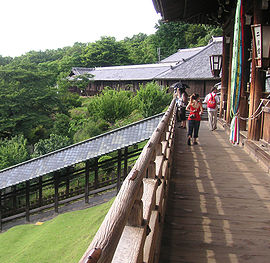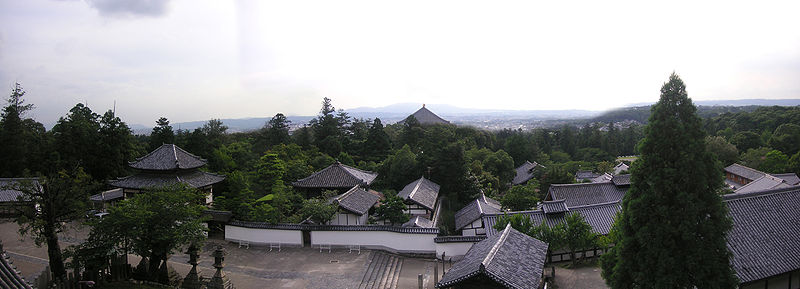
Nigatsu-do
Encyclopedia

Todai-ji
, is a Buddhist temple complex located in the city of Nara, Japan. Its Great Buddha Hall , the largest wooden building in the world, houses the world's largest bronze statue of the Buddha Vairocana, known in Japanese simply as Daibutsu . The temple also serves as the Japanese headquarters of the ...
, a temple in Nara
Nara, Nara
is the capital city of Nara Prefecture in the Kansai region of Japan. The city occupies the northern part of Nara Prefecture, directly bordering Kyoto Prefecture...
, Japan
Japan
Japan is an island nation in East Asia. Located in the Pacific Ocean, it lies to the east of the Sea of Japan, China, North Korea, South Korea and Russia, stretching from the Sea of Okhotsk in the north to the East China Sea and Taiwan in the south...
. Nigatsu-dō is located to the east of the Great Buddha Hall, on the hillside of Mount Wakakusa
Mount Wakakusa
, also known as Mount Mikasa , is an high mountain located in Nara, Nara Prefecture, Japan, beyond to the east from Nara Park....
. It includes several other buildings in addition to the specific hall named Nigatsu-dō, thus comprising its own sub-complex within Tōdai-ji.
History
Nigatsu-dō was founded by a monk by the name of Sanetada in 752, but the Buddhist monk JitchuJitchū
was a Buddhist monk in Nara Japan of the Kegon sect, and pupil of Roben. In his later years, Jitchu oversaw the expansion of Todaiji temple, and introduced liturgy and rituals still used today. The most noteworthy of these ceremonies is the Shuni-e repentance ceremony established by Jitchu at the...
, a pupil of Rōben
Roben
, also known as Ryōben, was a Japanese Buddhist monk of the Kegon sect, and clerical founder of the Tōdai-ji temple in Nara, Japan. He is popularly known as the ....
, later introduced a repentance service dedicated to the image of the eleven-faced Bodhisattva, Kannon in 760. It has taken place as an annual rite since 760 without any break. The service has come to be known as Shuni-e
Shuni-e
The is a ceremony held each year at certain Buddhist temples in Japan. The name comes from its observance in the second month of the lunisolar calendar. Today, the service is usually held in either February or March, depending on temples....
(修二会, lit. Second-Month Service), as it was held in the second month of the traditional lunisolar calendar
Lunisolar calendar
A lunisolar calendar is a calendar in many cultures whose date indicates both the moon phase and the time of the solar year. If the solar year is defined as a tropical year then a lunisolar calendar will give an indication of the season; if it is taken as a sidereal year then the calendar will...
. At present, it starts on March 1 and ends on the 15th of the month. Omizutori
Omizutori
Omizutori , or the annual, sacred Water-Drawing festival, is a Japanese Buddhist festival that takes place in the Nigatsu-dō of Tōdai-ji, Nara, Japan. The festival is the final rite in observance of the two week-long Shuni-e ceremony. This ceremony is to cleanse the people of their sins as well as...
, which means taking sacred water, has become the popular name of the ceremony.
While the first Shuni-e service is said to have been held by Jichu in another temple in 752
752
Year 752 was a leap year starting on Saturday of the Julian calendar. The denomination 752 for this year has been used since the early medieval period, when the Anno Domini calendar era became the prevalent method in Europe for naming years.- Europe :* Cuthred of Wessex leads a successful...
, the original construction of Nigatsu-dō hall is estimated to have completed only somewhere between 756 and 772. Nigatsu-dō was destroyed in 1667 due to a fire.
- 1667 (Kanbun 7): After fire destroyed the main temple structure, work on rebuilding at Nara commenced.
Re-construction of Nigatsu-do is completed in 1669. In 1944, it was chosen by Japan as one of the most important cultural aspects of the country.
Architecture
Although the hall was saved from civil wars in 1180 and 1567 in which the Great Buddha Hall was lost, it was burnt down during the Shuni-e service of 1667. The hall was rebuilt two years later.The current main hall of Nigatsu-dō is a designated National Treasure
National treasures of Japan
National Treasures are the most precious of Japan's Tangible Cultural Properties, as determined and designated by the Agency for Cultural Affairs...
. The hall holds two Kannons, a large one and a small one, although both of them are classified as Hibutsu (秘仏) - "secret Buddhas" - and therefore are not publicly shown.

See also
- OmizutoriOmizutoriOmizutori , or the annual, sacred Water-Drawing festival, is a Japanese Buddhist festival that takes place in the Nigatsu-dō of Tōdai-ji, Nara, Japan. The festival is the final rite in observance of the two week-long Shuni-e ceremony. This ceremony is to cleanse the people of their sins as well as...
, the climax of Shuni-e service which takes place on March 12th every year. - For an explanation of terms concerning Japanese Buddhism, Japanese Buddhist art, and Japanese Buddhist temple architecture, see the Glossary of Japanese BuddhismGlossary of Japanese BuddhismThis is the glossary of Japanese Buddhism, including major terms the casual reader might find useful in understanding articles on the subject. Words followed by an asterisk are illustrated by an image in one of the photo galleries...
.

